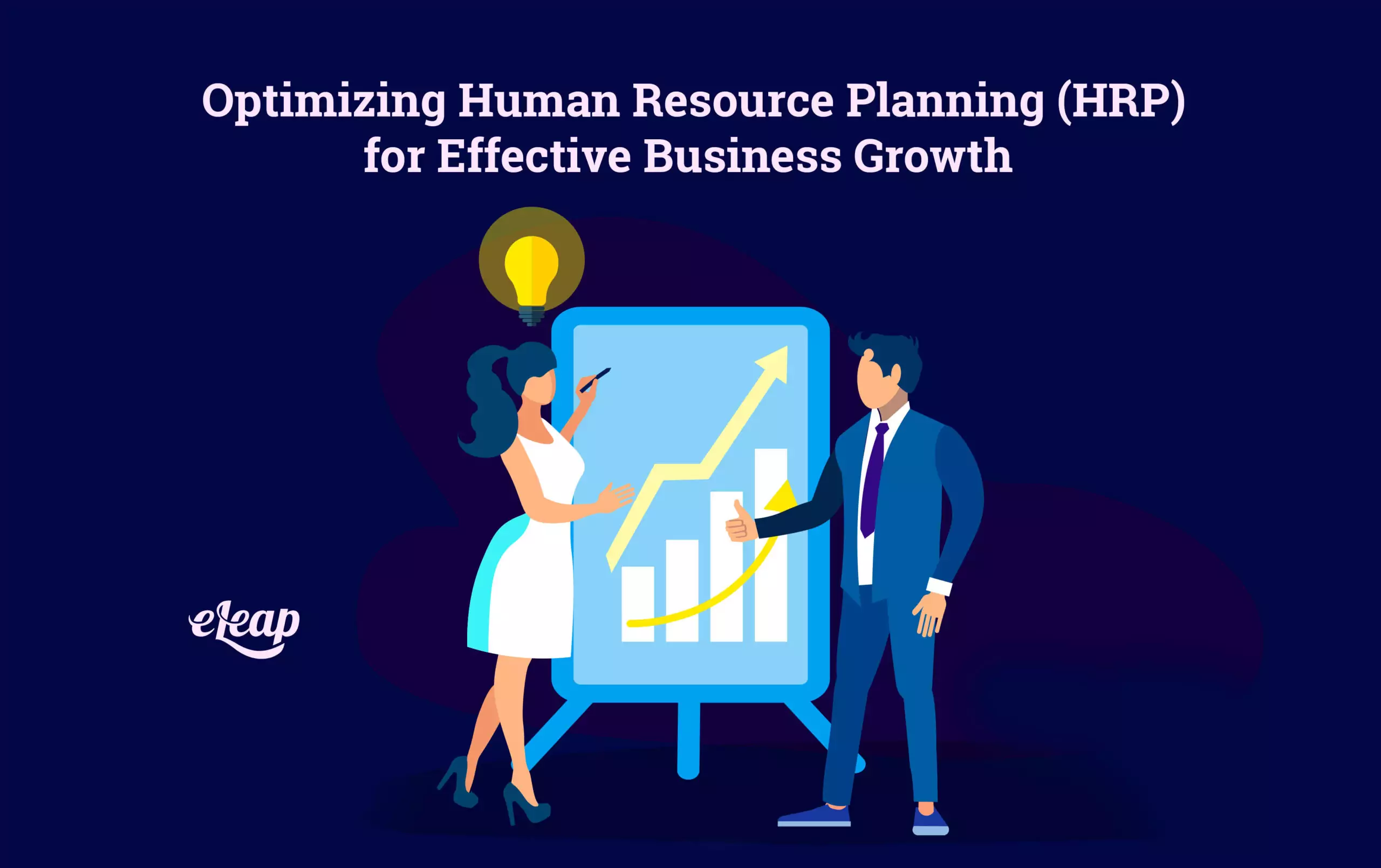Optimizing Human Resource Planning (HRP) for Effective Business Growth

Human Resource Planning (HRP) is a crucial process that involves forecasting, analyzing, and managing its workforce needs to ensure the right people are in the right positions at the right time. It encompasses various aspects of human resource management, aiming to align personnel requirements with the organization’s strategic goals and objectives.
Key steps in the HRP process include:

Forecasting Demand: This step involves estimating future workforce requirements based on factors such as business growth, market trends, technological advancements, and anticipated changes in the industry. It helps organizations determine how many employees will be needed and in which roles.
Analyzing Supply: Here, the existing workforce is evaluated in terms of skills, qualifications, experience, and performance. This assessment helps identify gaps between the current employee’s capabilities and the skills required for future roles.
Identifying Gaps: By comparing the forecasted demand with the current workforce supply, organizations can identify potential shortages or surpluses of employees in different job categories. This enables HR professionals to address imbalances proactively.
Developing Action Plans: HR develops action plans to address workforce deficiencies based on the identified gaps. These plans may involve strategies such as hiring, training and development, promotions, transfers, or even downsizing in case of surplus.
Implementation: This phase involves executing action plans. HR works on recruitment, training programs, skill development initiatives, and other activities necessary to bridge the gaps and align the workforce with the organization’s goals.
Monitoring and Evaluation: Regular monitoring and assessment of the workforce’s progress and the effectiveness of the implemented strategies is essential. Adjustments can be made based on the outcomes to ensure the organization remains on track.
The benefits of effective HRP include:
- Improved employee performance.
- Enhancing organizational efficiency.
- Better workforce utilization.
- Reduced turnover.
- The ability to respond quickly to changing market conditions.
It helps HR departments anticipate challenges and devise strategies to overcome them, thereby contributing to the organization’s long-term success.
In the dynamic landscape of today’s business world, Human Resource Planning (HRP) stands as a critical foundation for organizational success. Efficiently managing human resources ensures businesses have the right talent at the right time, propelling growth and enhancing competitiveness. This comprehensive guide delves into the intricacies of HRP, providing actionable insights, FAQs, and strategies for seamless implementation.
What is Human Resource Planning (HRP)?
Human Resource Planning (HRP) is a strategic process that involves identifying an organization’s current and future human resource needs, determining the required skills and competencies, and devising strategies to meet these needs. It encompasses various aspects, from talent acquisition and development to performance management and succession planning. HRP is essential for aligning an organization’s workforce with its goals and ensuring optimal resource utilization.
The importance of Human Resource Planning (HRP)
Effective HRP offers numerous benefits that contribute to an organization’s success:
Anticipating Talent Needs: HRP enables businesses to anticipate future talent requirements based on growth projections, industry trends, and technological advancements. This foresight helps prevent talent shortages and surpluses.
Enhancing Efficiency: By ensuring the right people are in the right roles, HRP boosts overall operational efficiency and productivity. This minimizes employee turnover and reduces recruitment costs.
Supporting Strategic Goals: HRP aligns human resources with the organization’s strategic goals, ensuring that every employee’s efforts contribute to the company’s mission.
Facilitating Succession Planning: Effective HRP identifies potential leaders and nurtures their skills for future leadership roles, ensuring a seamless transition.
Human Resource Planning (HRP) Process.
The HRP process involves several key steps
Environmental Scan
This step involves analyzing internal and external factors that could impact workforce planning. Internal factors may include employee skills and performance, while external factors encompass economic conditions, industry trends, and technological advancements.
Forecasting the Demand
Forecasting demand involves predicting the organization’s future workforce needs. Business growth, expansion plans, and changes in market demand influence this. Data-driven analysis and predictive tools play a crucial role in accurate demand forecasting.
Assessing the supply
Assessing supply involves evaluating the current workforce’s skills, competencies, and availability. This step helps identify potential skill gaps and areas for development within the existing workforce.
Gap analysis
Gap analysis compares the forecasted demand with the assessed supply to identify discrepancies. This reveals whether the organization has a surplus or shortage of talent and guides further planning.
Developing strategies
Organizations develop strategies to address talent shortages or surpluses based on a gap analysis. These strategies may involve recruitment, training and development programs, internal promotions, or workforce downsizing.
Implementation and monitoring
Implementing HRP strategies requires effective execution and continuous monitoring. Regular evaluation helps organizations adapt to changing circumstances and make necessary adjustments.
FAQs about Human Resource Planning (HRP)
Q: What role does technology play in HRP?
A: Technology aids in data analysis, trend prediction, and efficient workforce management, enhancing the accuracy and effectiveness of HRP.
Q: Is HRP only for large corporations?
A: No, HRP is valuable for organizations of all sizes, as it ensures optimal resource allocation and supports growth.
Q: How often should an organization revisit its HRP strategies?
A: Organizations should review and update their HRP strategies annually or whenever significant changes occur.
Q: Can HRP prevent employee turnover?
A: By aligning employees with their roles and career growth opportunities, HRP reduces turnover and boosts job satisfaction.
Q: What is the relationship between HRP and succession planning?
A: HRP identifies high-potential employees for succession planning, ensuring a pool of qualified candidates for key positions.
Q: How does globalization impact HRP?
A: Globalization introduces diverse workforce challenges, and HRP helps organizations adapt by recruiting, training, and managing a culturally aware workforce.
Conclusion
Human Resource Planning (HRP) is a cornerstone of success in the ever-evolving business landscape. HRP optimizes resource allocation, enhances efficiency, and supports growth by aligning an organization’s workforce with its strategic goals. Understanding the HRP process, its significance, and its impact on various aspects of business operations empowers organizations to thrive amidst change. Embrace HRP as a catalyst for excellence, and witness your business flourish.